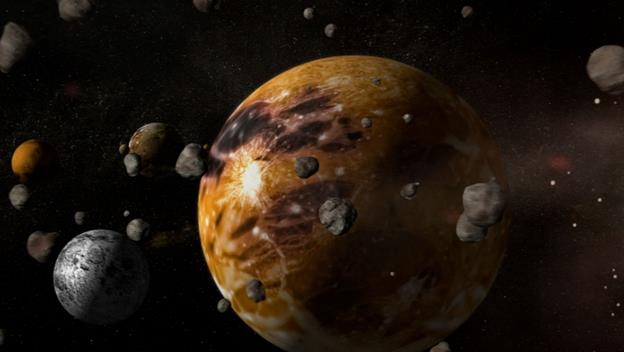Planet Biyo

Planet Biyo is a minor planet named after a Filipino teacher, Dr. Josette Biyo, who was the first Asian winner of the Intel Excellence in Teaching Award. It is listed as planet 13241 by the International Astronomical Union and can be found in the Main Asteroid Belt between Mars and Jupiter. It is between three to nine kilometers in diameter. Its semi-major axis falls 2.2731250 astronomical units away from the center of the sun, and its perihelion distance (or the body’s distance from the sun at its closest approach) fall at 2.1269244 AU. The axis of 13241 Biyo has an inclination of 7.30417 degrees, and its mean anomaly falls at 285.18521 degrees. It completes one orbital rotation roughly every 1251 days, or 3.43 years, at 0.28758689 degrees per day.13241 Biyo has been observed 549 times since it was first seen in 1975. It was 1.979 AU or 29,605,418 kilometers from Earth (2.397 AU or 35,858,609 kilometers from the sun) when it was last observed on 17 November 2009.
Little is known about 13241 Biyo because of its dimunitive size and the dense concentration of asteroids in its vicinity. There are many minor planets in our solar system. Planet Biyo is one of them, and a lot of scientists are astonished with these discoveries. Exploring the unknown in the vast of space is really amazing for us human beings. Space and time has ever been a mystery, there are still a lot of things that we need to understand about the solar system. It’s always a dream Discovering planets like the planet Biyo is really a step in achieving this dream.
Minor planets aren’t that popular to some but they are still studied by our scientists. A minor planet is an astronomical object in direct orbit around the Sun that is neither a planet nor originally classified as a comet. Minor planets can be dwarf planets, asteroids, trojans, centaurs, Kuiper belt objects, and other trans-Neptunian objects. The orbits of 620,000 minor planets were archived at the Minor Planet Center by 2013. Minor-planet naming is not always a free-for-all: there are some populations for which rules have developed about the sources of names. For instance, centaurs (orbiting between Saturn and Neptune) are all named after mythological centaurs. While Jupiter trojans are named after heroes from the Trojan War.
Studying planets are always difficult but that’s not stopping us discover the wonders and mystery of the universe. We study our atmosphere to learn more new things. The atmosphere is an important transitional zone between the solid planetary surface and the higher rarefied ionizing and radiation belts. Not all planets have atmospheres: their existence depends on the mass of the planet, and the planet’s distance from the Sun, too distant and frozen atmospheres occur. Besides the four gas giant planets, almost all of the terrestrial planets (Earth, Venus, and Mars) have significant atmospheres. Two moons have significant atmospheres: Saturn’s moonTitan and Neptune’s moon Triton. A tenuous atmosphere exists around Mercury as well.
Exploring and knowing the “unknown” are very helpful in knowing what’s “beyond”. It’s always fascinating each time we human beings discover something new, and Planet Biyo is a testament to that.
